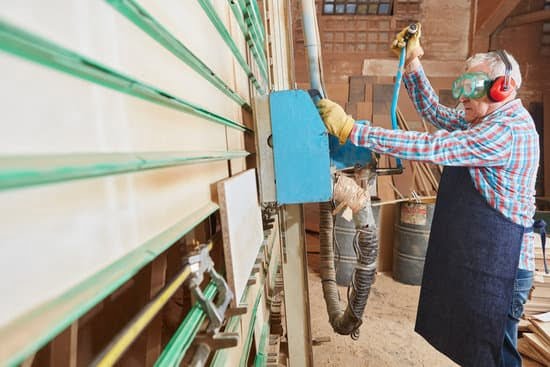When embarking on a woodworking project, one of the key considerations is choosing the right type of screw. Understanding what type of screw for woodworking is essential to ensure the structural integrity and longevity of your creations. Screws play a vital role in joining different pieces of wood together, creating sturdy and durable furniture, structures, and more.
In this comprehensive guide, we will delve into the world of screws in woodworking, starting with the basics. From the various types of screws commonly used in woodworking to factors to consider when selecting the right screw for your project, we will cover it all. Whether you are a seasoned woodworker or just starting out, having a solid understanding of screws and their applications is crucial for successful outcomes.
By exploring topics such as wood screws versus metal screws, screw sizes and lengths, coatings, driving techniques, and maintenance tips, you will be equipped with the knowledge needed to tackle any woodworking project with confidence. With the right screws chosen judiciously for each task at hand, you can ensure that your creations stand the test of time and showcase your craftsmanship effectively.
Different Types of Screws
When it comes to woodworking, choosing the right type of screw is crucial for the success and longevity of your project. There are various types of screws available in the market, each designed for specific purposes and materials. Understanding the different types of screws commonly used in woodworking can help you make informed decisions when selecting the appropriate fastener for your projects.
Here is an overview of some common types of screws used in woodworking:
- Wood Screws: As the name suggests, wood screws are specifically designed for use with wood materials. They have coarse threads and come in various lengths and sizes to accommodate different woodworking projects.
- Machine Screws: Machine screws are typically used in conjunction with nuts or tapped holes. They have finer threads than wood screws and are ideal for attaching metal hardware to wooden surfaces, such as drawer pulls or hinges.
- Drywall Screws: These specialized screws are designed for fastening drywall to wooden studs or frames. They have a fine thread that allows them to penetrate through drywall efficiently without causing damage.
Determining the right type of screw for woodworking depends on factors such as the type of wood being used, the weight-bearing capacity required, and the finish desired. It’s essential to consider these factors when selecting screws for your projects to ensure structural integrity and longevity. By understanding the characteristics of different types of screws, you can choose the most suitable option for your woodworking endeavors.
Choosing the Right Screw for Your Project
When it comes to woodworking, choosing the right screw is crucial for the success of your project. The type of screw you use can impact the overall strength and durability of the project, as well as its appearance. One of the key factors to consider when selecting a screw for woodworking is the material of both the screw and the wood you are working with. Different types of wood may require different types of screws for optimal performance.
Another important factor to consider when choosing a screw for woodworking is the head style. Common head styles for screws used in woodworking include flat heads, round heads, and pan heads. Each head style has its own advantages and disadvantages, so it is essential to select the right one based on your specific project requirements. For example, flat head screws are ideal for countersinking into wood, while round head screws provide a more decorative finish.
Additionally, considering the thread type of the screw is crucial when selecting the right one for your woodworking project. Coarse threads are typically used for soft woods, while fine threads are better suited for hardwoods.
Understanding the differences between thread types will help ensure that you choose a screw that provides optimal grip and holding power in your project. By taking into account these factors – material compatibility, head style, and thread type – you can make an informed decision on what type of screw to use for your woodworking endeavors.
| Wood Type | Recommended Screw Type |
|---|---|
| Softwoods | Coarse Thread Screws |
| Hardwoods | Fine Thread Screws |
Wood Screws vs Metal Screws
Woodworking projects often require the use of screws to secure joints and pieces together. When it comes to selecting the right screw for your woodworking project, one crucial decision to make is whether to use wood screws or metal screws. Each type has its own advantages and considerations that can impact the overall quality and durability of your work.
Wood screws are specifically designed for use in wood because of their threading, which provides a tight grip on wooden surfaces. These screws have a sharp point that helps drive them into wood without the need for a pilot hole in most cases. Wood screws come in various sizes, lengths, and head types to accommodate different woodworking needs. They are also typically made of steel or brass, providing strength and corrosion resistance ideal for woodworking applications.
On the other hand, metal screws are more versatile and can be used on a variety of materials beyond just wood. Metal screws are commonly made from steel or stainless steel and are designed to be durable and strong, making them suitable for heavy-duty applications. While metal screws can also be used in woodworking projects, they may not offer the same level of grip or pull-out strength as wood screws due to their threading design.
| Wood Screws | Metal Screws |
|---|---|
| Designed specifically for use in wood | More versatile and can be used on multiple materials |
| Have threading that provides a tight grip on wooden surfaces | Durable and strong, suitable for heavy-duty applications |
| Typically made of steel or brass for strength and corrosion resistance | Commonly made from steel or stainless steel |
Screw Sizes and Lengths
When it comes to woodworking projects, choosing the right screw size and length is crucial for the overall success and stability of your creation. The size and length of the screw you use will depend on various factors such as the type of wood you are working with, the thickness of the material, and the specific requirements of your project.
Understanding how to determine what is needed in terms of screw sizes and lengths can help you achieve professional results in your woodworking endeavors.
One important consideration when selecting screw sizes is the thickness of the wood being joined together. For thinner pieces of wood, shorter screws are typically sufficient to create a secure bond without poking through the other side. On the other hand, thicker pieces of wood may require longer screws to ensure a strong connection. It’s essential to measure the total thickness of the materials being joined to determine the appropriate screw length for your project.
In addition to considering wood thickness, it’s also important to take into account the type of joint you are creating. Different types of joints require specific screw sizes and lengths to provide optimal strength and stability.
For example, when joining two pieces of wood at a right angle, using screws that are too short may result in a weak joint that is prone to splitting or shifting over time. By understanding how different joints impact screw selection, you can ensure that your woodworking projects are durable and reliable.
Wood Screws Coatings
Benefits of Coatings
One of the primary benefits of wood screw coatings is their ability to provide protection against corrosion. This is especially important when working with outdoor or moisture-prone wood projects. Coated screws can withstand exposure to elements such as rain, snow, and humidity without deteriorating over time. Additionally, some coatings offer lubrication properties that make driving screws into hardwoods or dense woods much easier, reducing the likelihood of splitting or damaging the material.
Another advantage of wood screw coatings is their ability to enhance the overall aesthetics of your woodworking projects. Coated screws are available in various colors and finishes, allowing you to choose one that complements or contrasts with the wood you are using. This attention to detail can elevate the look of your finished piece and create a cohesive design that showcases your craftsmanship.
Considerations When Choosing Coatings
When selecting a coating for your wood screws, it is essential to consider the specific requirements of your project. Different coatings may have varying levels of resistance to corrosion or environmental factors. For instance, zinc-plated screws are suitable for indoor applications but may not be ideal for outdoor furniture exposed to constant moisture. In contrast, stainless steel screws are highly resistant to rust but typically come at a higher cost.
Additionally, certain coatings may interact poorly with certain types of wood, causing discoloration or chemical reactions that compromise both the screw and the material. It’s crucial to research and test different coatings on scrap pieces before committing to a specific type for your project. By carefully considering these factors and weighing the benefits against potential drawbacks, you can confidently choose the right wood screw coating for your woodworking endeavors.
Tips for Driving Screws Into Wood
When it comes to woodworking, using the right type of screw is crucial for ensuring the success and longevity of your projects. But it’s not just about choosing the correct screw – how you drive those screws into the wood can make all the difference. Here are some tips for driving screws into wood effectively while avoiding common mistakes:
- Pre-Drilling: Before driving a screw into wood, it’s important to pre-drill a pilot hole. This helps prevent the wood from splitting and makes it easier to drive the screw in smoothly. The size of the pilot hole should be slightly smaller than the diameter of the screw.
- Use Proper Technique: When using a drill or screwdriver to drive screws into wood, make sure to apply consistent pressure and keep the tool straight. Angling the tool can cause the screw to go in at an angle, leading to poor grip and potentially damaging the wood.
- Choose the Right Screwdriver Bit: Using a properly fitting screwdriver bit is essential for driving screws effectively. A mismatched bit can strip the screw head, making it difficult to drive or remove later on. Make sure to match the bit size and type with the screw you are using.
By following these tips, you can ensure that your screws are driven into wood securely and without any mishaps along the way. Properly driven screws will not only enhance the overall look of your woodworking projects but also provide structural integrity for years to come. Remember, attention to detail in every step of your woodworking process, including driving screws, will result in high-quality finished products that you can be proud of.
Maintenance and Care for Woodworking Screws
Proper Storage
One of the crucial aspects of maintaining woodworking screws is proper storage. Keeping your screws in a dry, cool environment can prevent them from rusting or corroding over time. It is advisable to store screws in separate containers based on their sizes and types to avoid confusion and ensure easy access when needed. Additionally, labeling each container can help you quickly identify the right screw for your project, saving time and effort.
Regular Cleaning
Regular cleaning of woodworking screws is essential to maintain their performance and longevity. After each use, it is recommended to remove any debris or wood shavings that may have accumulated on the screws. This can be easily done using a brush or compressed air. If you notice any signs of rust or corrosion, it’s best to clean the affected screws with a mild solution and then dry them thoroughly before storing them back in their designated containers.
Avoiding Over-Tightening
Over-tightening screws during woodworking projects can not only damage the wood but also lead to premature wear and tear of the screws themselves. To ensure the longevity of your woodworking screws, it’s important to use the right amount of force when driving them into the wood. Investing in a high-quality screwdriver or drill with adjustable torque settings can help prevent over-tightening and keep your screws in top condition for future projects.
Conclusion
In conclusion, choosing the right type of screw for woodworking is crucial for the success and longevity of your projects. Understanding the basics of screws in woodworking, as well as the different types available, is essential in ensuring that your creations are sturdy and durable. Factors such as materials, project requirements, and desired finish should all be taken into account when selecting the appropriate screw for your woodworking endeavor.
When deciding between wood screws and metal screws for woodworking projects, it is important to consider the specific needs of the project. While wood screws are designed specifically for use with wood materials and provide a stronger hold, metal screws may be suitable for certain applications where strength or corrosion resistance is a priority. Careful consideration of these factors can help you choose the best option for your woodworking project.
In addition, understanding screw sizes, lengths, coatings, as well as tips for driving screws into wood can further enhance the quality and durability of your woodworking projects. By paying attention to these details and investing in proper maintenance and care for your screws, you can ensure that your creations stand the test of time. Ultimately, using the right screws for woodworking not only improves the appearance of your finished products but also guarantees their stability and reliability.
Frequently Asked Questions
What Screws Do I Need for Woodworking?
The type of screws you need for woodworking will depend on the project you are working on. Generally, it is recommended to use wood screws for woodworking, as they are specifically designed to grip into the wood securely without causing splitting.
It is important to choose the right length and thickness of screw based on the thickness of the wood you are using.
What Are the 2 Common Types of Screws Used in Woodworking?
Two common types of screws used in woodworking are wood screws and drywall screws. Wood screws have a coarser thread and a sharp point, which allows them to penetrate into the wood easily and provide strong holding power.
Drywall screws, on the other hand, have finer threads and are not ideal for woodworking as they may not hold up well in wood applications.
Do I Need Special Screws for Wood?
While special screws are not always necessary for woodworking, there are certain factors to consider when choosing the right screws for your project. It is important to select screws that are appropriate for the type of wood you are using, as different species of wood may require specific types of screws to prevent damage or splitting.
Additionally, if you are working with hardwoods or softwoods, choosing the correct screws can ensure a secure and durable joint. Ultimately, investing in quality screws designed for woodworking can lead to better results and a stronger finished product.

Hi everyone! I’m a woodworker and blogger, and this is my woodworking blog. In my blog, I share tips and tricks for woodworkers of all skill levels, as well as project ideas that you can try yourself.





